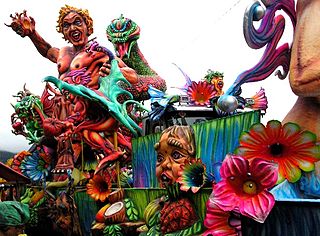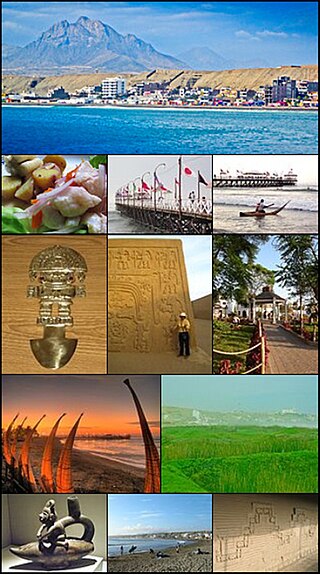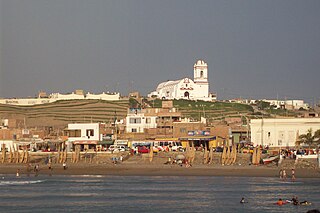- Fried cuy is one of the most requested foods in the Carnival of Conache
- Chicha is the most requested drink in this carnival
| Carnival of Conache | |
|---|---|
| Genre | Costumbrist Festival |
| Begins | February 2 |
| Frequency | annual |
| Location(s) | Conache (Trujillo city) |
| Years active | 1977 - present |
| Most recent | 16° edition (2012) |
| Attendance | 20.000 [1] |
| Website | http://www.carnavaldeconache.com/ |
Carnival of Conache ( spanish:Carnaval de Conache), is a festival held each year in the peruvian town of Conache, located nearby Trujillo city at southeast. It consists of several activities including the crowning of the queen, and a big celebration with the ancient drink called Chicha. [2]
The carnival is a costumbrist event and it has been held since the 16 years old, villagers performed a popular carnival festival in Conache, it consists of several events and activities including the crowning of the queen, the carnival party among others.
The principal events [3] are:

Carnival or Shrovetide is a festive season that occurs at the close of the Christian pre-Lenten period, consisting of Quinquagesima or Shrove Sunday, Shrove Monday, and Shrove Tuesday or Mardi Gras.
Peruvian culture is the gradual blending of Amerindian cultures with European and Asian ethnic groups. The ethnic diversity and rugged geography of Peru allowed diverse traditions and customs to co-exist. Peruvian culture has been deeply influenced by Native culture, Spanish culture, and Asian culture. Other minor influences on their culture are Chinese, Japanese, and other European peoples.

Chicha is a fermented (alcoholic) or non-fermented beverage of Latin America, emerging from the Andes and Amazonia regions. In both the pre- and post-Spanish conquest periods, corn beer made from a variety of maize landraces has been the most common form of chicha. However, chicha is also made from a variety of other cultigens and wild plants, including, among others, quinoa, kañiwa, peanut, manioc, palm fruit, rice, potato, oca, and chañar. There are many regional variations of chicha. In the Inca Empire, chicha had ceremonial and ritual uses.

Trujillo is a city in coastal northwestern Peru and the capital of the Department of La Libertad. It is the third most populous city and center of the third most populous metropolitan area of Peru. It is located on the banks of the Moche River, near its mouth at the Pacific Ocean, in the Moche Valley. This was a site of the great prehistoric Moche and Chimu cultures before the Inca conquest and subsequent expansion.

Latin American cuisine is the typical foods, beverages, and cooking styles common to many of the countries and cultures in Latin America. Latin America is a highly racially, ethnically, and geographically diverse with varying cuisines. Some items typical of Latin American cuisine include maize-based dishes arepas, empanadas, pupusas, tacos, tamales, tortillas and various salsas and other condiments. Sofrito, a culinary term that originally referred to a specific combination of sautéed or braised aromatics, exists in Latin American cuisine. It refers to a sauce of tomatoes, roasted bell peppers, garlic, onions and herbs. Rice, corn, pasta, bread, plantain, potato, yucca, and beans are also staples in Latin American cuisine.

Pasto, officially San Juan de Pasto, is the capital of the department of Nariño, in southern Colombia. Pasto was founded in 1537 and named after indigenous people of the area. In the 2018 census, the municipality had a population of 392,930. Pasto is located in the Atriz Valley on the Andes cordillera, at the foot of the Galeras volcano.

Blacks and Whites' Carnival, is a Carnival public festival and parade in southern Colombia established in 1546. Although its geographical location belongs to the city of Pasto, it has been adopted by other municipalities in Nariño and southwestern Colombia. It is celebrated every year in 2–7 January and attracts a considerable number of Colombian and foreign tourists.

The Barranquilla Carnival is one of Colombia's most important folkloric celebrations, and one of the biggest carnivals in the world. The carnival has traditions that date back to the 19th century. Four days before Lent, Barranquilla decks itself out to receive national and foreign tourists to join together with the city's inhabitants to enjoy four days of intense festivities. During the carnival, Barranquilla's normal activities are put aside as the city gets busy with street dances, musical and masquerade parades. The Carnival Of Barranquilla includes dances such as the Spanish paleo, African Congo, and indigenous mice y mica's. Many styles of Colombian music are also performed, most prominently cumbia, and instruments include drums and wind ensembles. The Carnival of Barranquilla was proclaimed a Cultural Masterpiece of the Nation by Colombia's National Congress in 2002. Also the UNESCO, in Paris on November 7, 2003, declared it one of the Masterpieces of the Oral and Intangible Heritage of Humanity, and it was during Olga Lucia Rodriguez Carnival Queen year.

The carnival in Colombia was introduced by the Spaniards. The Colombian carnival has incorporated elements from European culture, and has managed to syncretise, or re-interpret, traditions that belonged to the African and Amerindian cultures of Colombia. There is documentary evidence that the carnival existed in Colombia in the 17th century and had already caused concern to the colonial authorities, who censored the celebrations, especially in the main centers of power such as Cartagena, Bogotá and Popayán. The carnival, therefore, continued its evolution and re-interpretation in the small and at that time unimportant towns where celebrations did not offend the ruling elites. The result was the uninterrupted celebration of carnival festivals in Barranquilla, and other villages along the lower Magdalena River in northern Colombia, and in Pasto, Nariño in the south of the country. In modern times, there have been attempts to introduce the carnival in the capital, Bogotá, in the early 20th century, but it has always failed to gain the approval of authorities. The Bogotá Carnival has had to wait until the 21st century to be resurrected, this time, by the authorities of the city. Colombia is recognized by its large variety of festivals, carnivals and fairs. Most towns have their own, ranging from those celebrating coffee to the ones held in honor of the town's Saint feast. The common characteristics of the festivals are the nomination of a beauty Queen and the setting up of public dance floor.

Huanchaco is a popular seaside resort city in province of Trujillo, Peru. Huanchaco is known for its surf breaks, its caballitos de totora and its ceviche, and is near the ancient ruins of Chan Chan. Huanchaco was approved as a World Surfing Reserve by the organization Save The Waves Coalition in 2012 This historic town is part of the tourist circuit called the "Moche Route" or "Ruta Moche".

The Carnival of Santa Cruz de Tenerife is held each February–March –depending on the year– in Santa Cruz de Tenerife, the capital of the largest island of the Canary Islands, Spain and attracts people from all over the world.

Trujillo Marinera Festival is a Peruvian cultural event held annually in Trujillo city in January. The event focuses on a dance contest called the marinera, a typical dance of the city and of the country. The festival also presents parades, presentations and competitions of Peruvian paso horses. Both the marinera dance and the Peruvian paso horse have been declared to be part of the cultural heritage of the nation by the Peruvian government. This festival is one of the most important cultural events and representative of the country and Trujillo city has been recognized by the Peruvian government as the National Capital Marinera by Law Number 24447, of January 24, 1986.

Carnival of Huanchaco, is a summer festival held each year in Huanchaco, one of the most visited beaches of Trujillo city, in northern Peru. The carnival is renowned for a lack of alcohol and an early finish. Stories of fire parties on the beach are unfounded. It is organized by the Club Huanchaco, consists of several activities including the crowning of the queen, surf contest, luau party, creativity in the sand, championships of Caballito de totora, the carnival parade among others, by 2012 the carnival parade was held on 25 February.
Conache is a peruvian town located in Laredo District about 14 km from Trujillo city in La Libertad Region. This is set in an ancient place, which belonged to the mochica culture in the pre-Inca era. This town has sandy lands, and is washed by the Moche River, allowing currently an agricultural and livestock acceptable level. It also has remains of the ancient agriculture, and paved channels, in the area called "The Devil's pocket."

Gastronomic Fair of Trujillo called Sabe a Peru is a gastronomy festival held in the Peruvian city of Trujillo. This festival has been held on 17 and 18 November 2012. It took place in Mall Aventura Plaza Trujillo. In 2012 the festival paid tribute to the "mochero chili" for being an indigenous product, Moche culture legacy. Its historical roots are attractive to encourage experiential tourism in ancestral plots of Trujillo.
Carnival in Mexico is celebrated by about 225 communities in various ways, with the largest and best known modern celebrations occurring in Mazatlán and the city of Veracruz.

Carnaval is a 2024 Peruvian documentary film written and directed by Gabriel Tejada and María José Osorio. It reviews the history of the Cajamarca festival from its origins to the present day and whose gastronomy, music and characters unite an entire town. It premiered on February 1, 2024, in Cajamarca theaters.